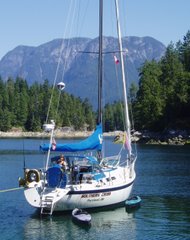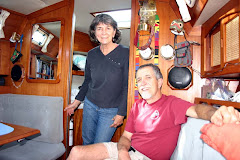With the truck packed full of food, camping gear, and boat parts, we headed out of Corvallis on Saturday October 22. We drove down the coast in beautiful weather, stopping to admire the view at Cape Blanco, and spending our first night at Humbug Mountain State Park. No picture to prove it, but we experienced our first ever "Green Flash" at an Oregon beach.

The next morning, we stopped to watch the elk rutting at Fern Canyon.

We made it to Mill Valley by late afternoon and enjoyed a 2-day visit with Dave and Jean from s/v
Exit Strategy. Dave took me on an exhilarating mountain bike ride to the top of Mt. Tamalpais.

From the Bay Area, we picked up the pace and made it to SoCal in only one day. We spent nearly a week visiting family members and picking up last minute items for the boat. Finally the time came to cross the border into Mexico, but despite an easy crossing, we didn't get far. We stopped to visit more cruising friends in Ensenada, Jan and Ramona on s/v
Jatimo, and ended up spending the night on their sturdy 30-footer. Jatimo and her crew are veterans of two crossings to the South Seas, and we enjoyed an evening of stories and good advice.
It was hard to leave Ensenada and our friends, but the rugged beauty of the Baja soon captured all our attention, especially after we passed El Rosario and headed into the mountainous interior. We stopped to photograph and admire the amazing landscape and plants,


and visited some cave paintings made by the elders who first came to live here, many thousands of years ago.

Still trying not to rush, we decided to take a newly-paved side road out to the coast at Asunción, where we had anchored on our way down the coast 2 years ago. We then left the pavement to make our way south along a rugged and mostly uninhabited coastline, where we found our own deserted beach and camped just above the pounding surf.

We also saw our second "Green Flash" of the trip, a particularly vivid one. A strip of emerald detached itself from the sun at the last instant of sunset, and hung above the horizon for an extra few moments. Wow! The next morning we had to partially deflate our tires to get back to the road from the beach, but after this slight delay, we soon found ourselves driving on smooth mudflats between La Bocana and Punta Abrejos. We stopped to birdwatch at an estero along the way.

From Abreojos, we were on new pavement most of the way back to the main highway, and we reached San Ignacio in time for lunch. This is a quaint town in a remarkable oasis-like setting.



After a brief stop to make arrangements for a whalewatching trip next January, we continued to a campground in Mulege, our 4th night in Baja. From here it was only about another 6 hours to our final destination, with some terrific mountain scenery along the way.

Most people reach La Paz in 2-3 days from the border, but we had managed to stretch it to 5 days (of course a lot of the extra time was spent stopping to find an Internet connection, so that I could keep up with my teaching responsibilities). After all the desolate scenery from the past several days, it was a bit of a shock to come over a rise and see the bay of La Paz spread out ahead of us. Our friends on s/v
Slacker call the northern approach to La Paz "tope-landia" (land of speed bumps) and it certainly matched that description!
We spent a couple of nights aboard s/v
Anon, with our friends Keith and Olina. Keith is a fellow telecommuter, but one with a lot more technical savvy than I have. Here we are enjoying a tasty dinner at Rancho Viejo.

After our 2-week road trip, it was time to park the car and board the overnight ferry to Mazatlán.

This last stage of the journey was by far the easiest, despite getting a "red light" (mandatory inspection) at the Customs station. We had our own cabin with en suite head and shower, and we pulled into the Port of Mazatlán feeling clean and rested.



A short ride by pulmonía, and we were finally back to our boat at the beautiful El Cid marina. She looks ready for another season of cruising (and so does the boat)!




















































